Analyzing Changes in Childhood and Children's Rights in the UK
VerifiedAdded on 2022/12/27
|8
|2921
|378
Essay
AI Summary
This essay provides a critical analysis of the changes in childhood and children's rights in the UK since the Victorian era. It examines the harsh realities of Victorian childhood, including child labor and the disparities between rich and poor children. The essay then explores key legislative changes an...
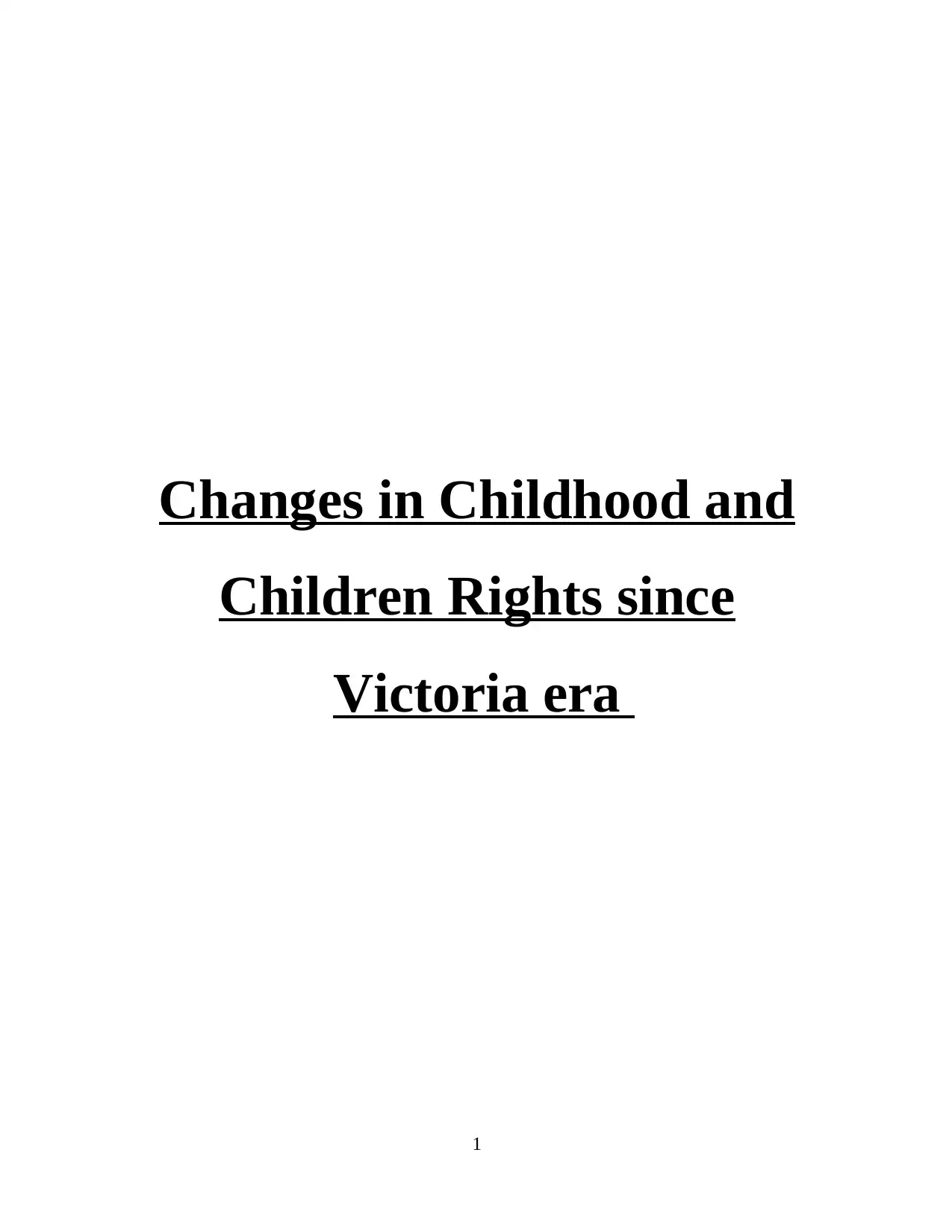
Changes in Childhood and
Children Rights since
Victoria era
1
Children Rights since
Victoria era
1
Paraphrase This Document
Need a fresh take? Get an instant paraphrase of this document with our AI Paraphraser
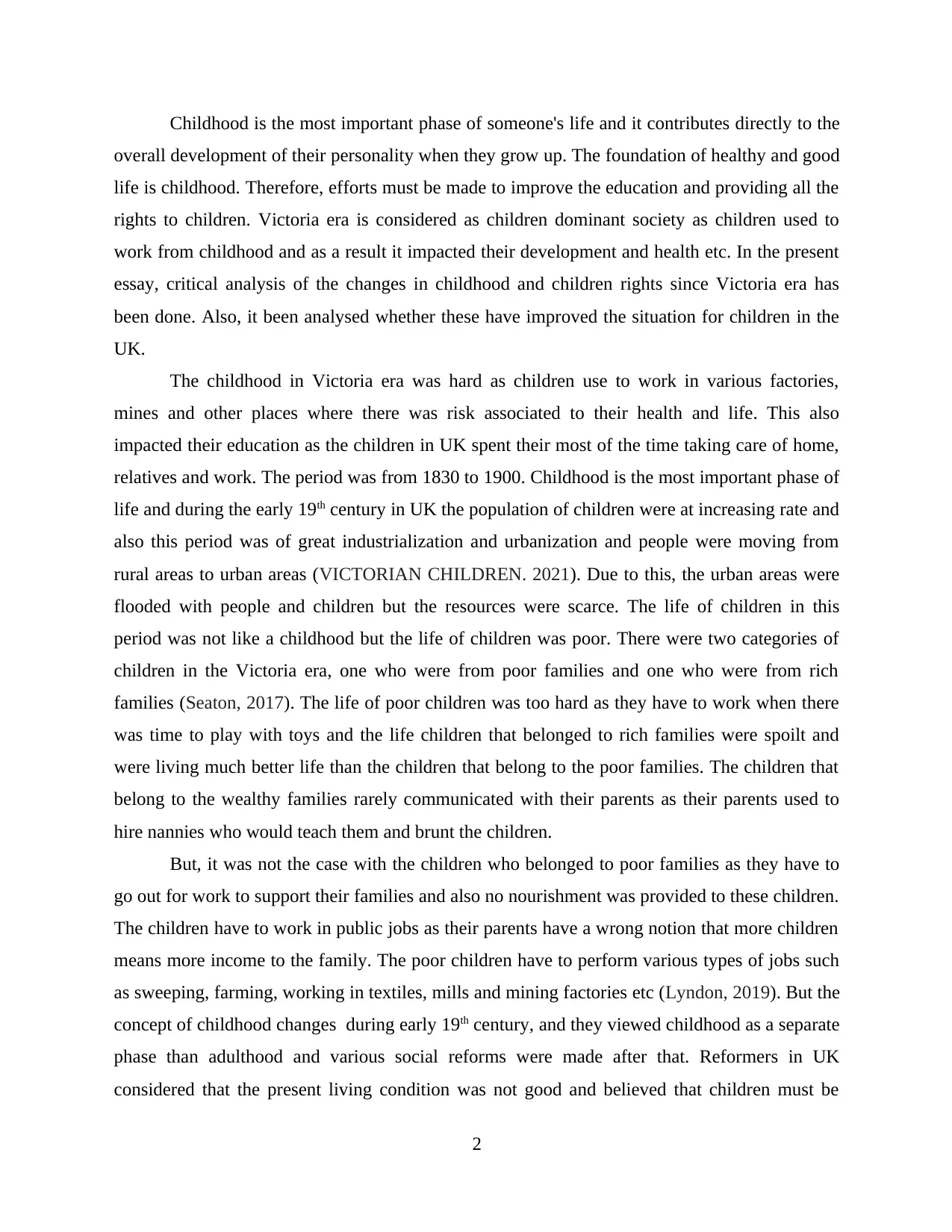
Childhood is the most important phase of someone's life and it contributes directly to the
overall development of their personality when they grow up. The foundation of healthy and good
life is childhood. Therefore, efforts must be made to improve the education and providing all the
rights to children. Victoria era is considered as children dominant society as children used to
work from childhood and as a result it impacted their development and health etc. In the present
essay, critical analysis of the changes in childhood and children rights since Victoria era has
been done. Also, it been analysed whether these have improved the situation for children in the
UK.
The childhood in Victoria era was hard as children use to work in various factories,
mines and other places where there was risk associated to their health and life. This also
impacted their education as the children in UK spent their most of the time taking care of home,
relatives and work. The period was from 1830 to 1900. Childhood is the most important phase of
life and during the early 19th century in UK the population of children were at increasing rate and
also this period was of great industrialization and urbanization and people were moving from
rural areas to urban areas (VICTORIAN CHILDREN. 2021). Due to this, the urban areas were
flooded with people and children but the resources were scarce. The life of children in this
period was not like a childhood but the life of children was poor. There were two categories of
children in the Victoria era, one who were from poor families and one who were from rich
families (Seaton, 2017). The life of poor children was too hard as they have to work when there
was time to play with toys and the life children that belonged to rich families were spoilt and
were living much better life than the children that belong to the poor families. The children that
belong to the wealthy families rarely communicated with their parents as their parents used to
hire nannies who would teach them and brunt the children.
But, it was not the case with the children who belonged to poor families as they have to
go out for work to support their families and also no nourishment was provided to these children.
The children have to work in public jobs as their parents have a wrong notion that more children
means more income to the family. The poor children have to perform various types of jobs such
as sweeping, farming, working in textiles, mills and mining factories etc (Lyndon, 2019). But the
concept of childhood changes during early 19th century, and they viewed childhood as a separate
phase than adulthood and various social reforms were made after that. Reformers in UK
considered that the present living condition was not good and believed that children must be
2
overall development of their personality when they grow up. The foundation of healthy and good
life is childhood. Therefore, efforts must be made to improve the education and providing all the
rights to children. Victoria era is considered as children dominant society as children used to
work from childhood and as a result it impacted their development and health etc. In the present
essay, critical analysis of the changes in childhood and children rights since Victoria era has
been done. Also, it been analysed whether these have improved the situation for children in the
UK.
The childhood in Victoria era was hard as children use to work in various factories,
mines and other places where there was risk associated to their health and life. This also
impacted their education as the children in UK spent their most of the time taking care of home,
relatives and work. The period was from 1830 to 1900. Childhood is the most important phase of
life and during the early 19th century in UK the population of children were at increasing rate and
also this period was of great industrialization and urbanization and people were moving from
rural areas to urban areas (VICTORIAN CHILDREN. 2021). Due to this, the urban areas were
flooded with people and children but the resources were scarce. The life of children in this
period was not like a childhood but the life of children was poor. There were two categories of
children in the Victoria era, one who were from poor families and one who were from rich
families (Seaton, 2017). The life of poor children was too hard as they have to work when there
was time to play with toys and the life children that belonged to rich families were spoilt and
were living much better life than the children that belong to the poor families. The children that
belong to the wealthy families rarely communicated with their parents as their parents used to
hire nannies who would teach them and brunt the children.
But, it was not the case with the children who belonged to poor families as they have to
go out for work to support their families and also no nourishment was provided to these children.
The children have to work in public jobs as their parents have a wrong notion that more children
means more income to the family. The poor children have to perform various types of jobs such
as sweeping, farming, working in textiles, mills and mining factories etc (Lyndon, 2019). But the
concept of childhood changes during early 19th century, and they viewed childhood as a separate
phase than adulthood and various social reforms were made after that. Reformers in UK
considered that the present living condition was not good and believed that children must be
2
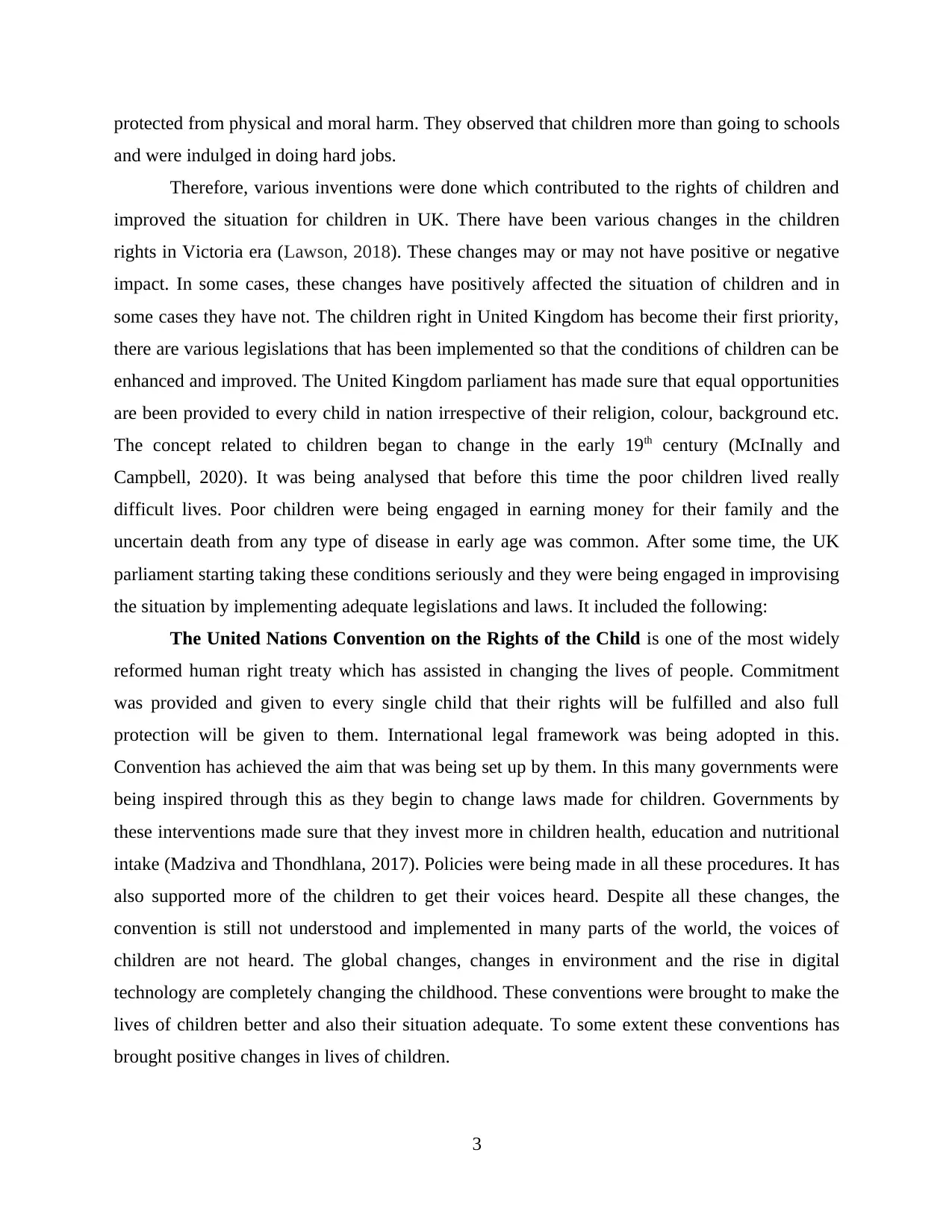
protected from physical and moral harm. They observed that children more than going to schools
and were indulged in doing hard jobs.
Therefore, various inventions were done which contributed to the rights of children and
improved the situation for children in UK. There have been various changes in the children
rights in Victoria era (Lawson, 2018). These changes may or may not have positive or negative
impact. In some cases, these changes have positively affected the situation of children and in
some cases they have not. The children right in United Kingdom has become their first priority,
there are various legislations that has been implemented so that the conditions of children can be
enhanced and improved. The United Kingdom parliament has made sure that equal opportunities
are been provided to every child in nation irrespective of their religion, colour, background etc.
The concept related to children began to change in the early 19th century (McInally and
Campbell, 2020). It was being analysed that before this time the poor children lived really
difficult lives. Poor children were being engaged in earning money for their family and the
uncertain death from any type of disease in early age was common. After some time, the UK
parliament starting taking these conditions seriously and they were being engaged in improvising
the situation by implementing adequate legislations and laws. It included the following:
The United Nations Convention on the Rights of the Child is one of the most widely
reformed human right treaty which has assisted in changing the lives of people. Commitment
was provided and given to every single child that their rights will be fulfilled and also full
protection will be given to them. International legal framework was being adopted in this.
Convention has achieved the aim that was being set up by them. In this many governments were
being inspired through this as they begin to change laws made for children. Governments by
these interventions made sure that they invest more in children health, education and nutritional
intake (Madziva and Thondhlana, 2017). Policies were being made in all these procedures. It has
also supported more of the children to get their voices heard. Despite all these changes, the
convention is still not understood and implemented in many parts of the world, the voices of
children are not heard. The global changes, changes in environment and the rise in digital
technology are completely changing the childhood. These conventions were brought to make the
lives of children better and also their situation adequate. To some extent these conventions has
brought positive changes in lives of children.
3
and were indulged in doing hard jobs.
Therefore, various inventions were done which contributed to the rights of children and
improved the situation for children in UK. There have been various changes in the children
rights in Victoria era (Lawson, 2018). These changes may or may not have positive or negative
impact. In some cases, these changes have positively affected the situation of children and in
some cases they have not. The children right in United Kingdom has become their first priority,
there are various legislations that has been implemented so that the conditions of children can be
enhanced and improved. The United Kingdom parliament has made sure that equal opportunities
are been provided to every child in nation irrespective of their religion, colour, background etc.
The concept related to children began to change in the early 19th century (McInally and
Campbell, 2020). It was being analysed that before this time the poor children lived really
difficult lives. Poor children were being engaged in earning money for their family and the
uncertain death from any type of disease in early age was common. After some time, the UK
parliament starting taking these conditions seriously and they were being engaged in improvising
the situation by implementing adequate legislations and laws. It included the following:
The United Nations Convention on the Rights of the Child is one of the most widely
reformed human right treaty which has assisted in changing the lives of people. Commitment
was provided and given to every single child that their rights will be fulfilled and also full
protection will be given to them. International legal framework was being adopted in this.
Convention has achieved the aim that was being set up by them. In this many governments were
being inspired through this as they begin to change laws made for children. Governments by
these interventions made sure that they invest more in children health, education and nutritional
intake (Madziva and Thondhlana, 2017). Policies were being made in all these procedures. It has
also supported more of the children to get their voices heard. Despite all these changes, the
convention is still not understood and implemented in many parts of the world, the voices of
children are not heard. The global changes, changes in environment and the rise in digital
technology are completely changing the childhood. These conventions were brought to make the
lives of children better and also their situation adequate. To some extent these conventions has
brought positive changes in lives of children.
3
⊘ This is a preview!⊘
Do you want full access?
Subscribe today to unlock all pages.

Trusted by 1+ million students worldwide
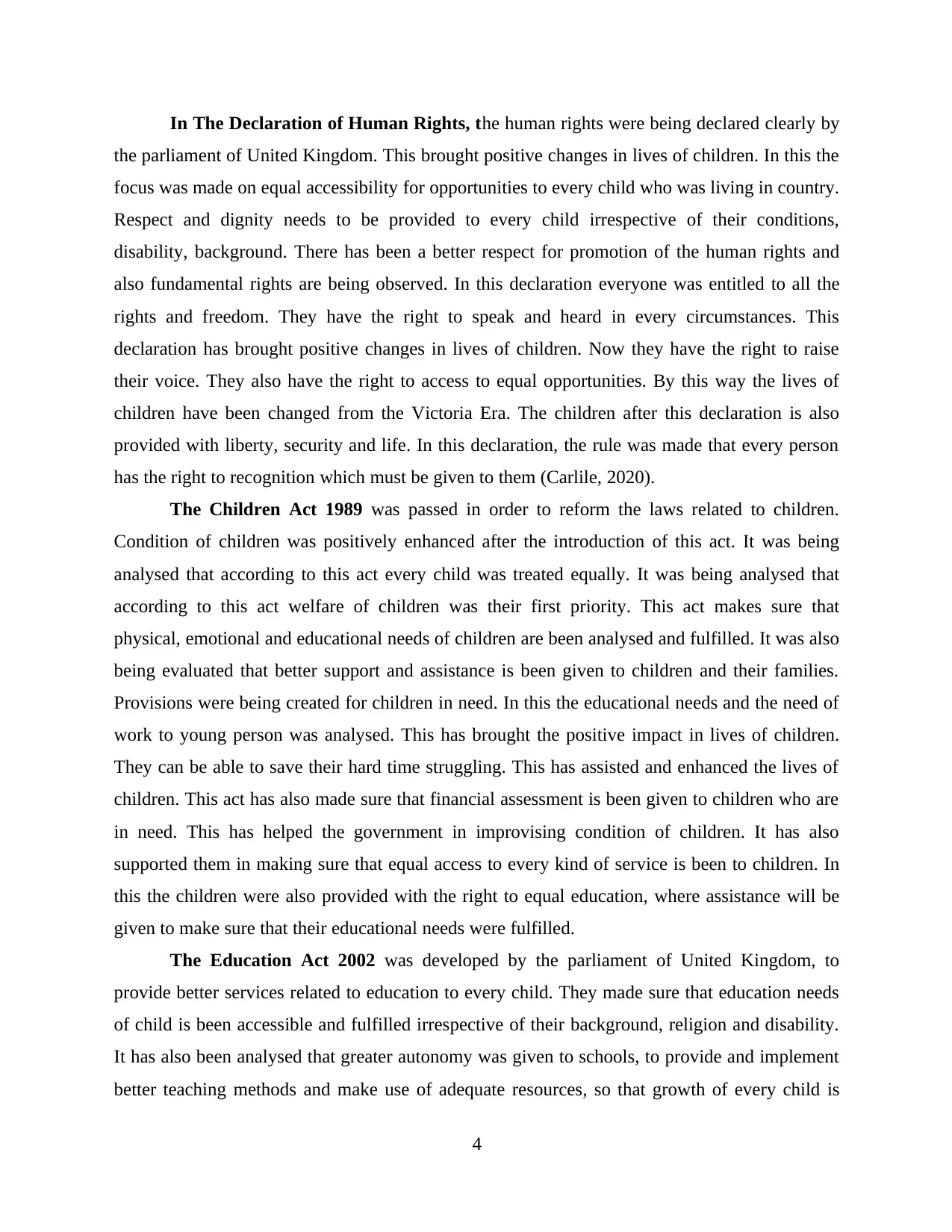
In The Declaration of Human Rights, the human rights were being declared clearly by
the parliament of United Kingdom. This brought positive changes in lives of children. In this the
focus was made on equal accessibility for opportunities to every child who was living in country.
Respect and dignity needs to be provided to every child irrespective of their conditions,
disability, background. There has been a better respect for promotion of the human rights and
also fundamental rights are being observed. In this declaration everyone was entitled to all the
rights and freedom. They have the right to speak and heard in every circumstances. This
declaration has brought positive changes in lives of children. Now they have the right to raise
their voice. They also have the right to access to equal opportunities. By this way the lives of
children have been changed from the Victoria Era. The children after this declaration is also
provided with liberty, security and life. In this declaration, the rule was made that every person
has the right to recognition which must be given to them (Carlile, 2020).
The Children Act 1989 was passed in order to reform the laws related to children.
Condition of children was positively enhanced after the introduction of this act. It was being
analysed that according to this act every child was treated equally. It was being analysed that
according to this act welfare of children was their first priority. This act makes sure that
physical, emotional and educational needs of children are been analysed and fulfilled. It was also
being evaluated that better support and assistance is been given to children and their families.
Provisions were being created for children in need. In this the educational needs and the need of
work to young person was analysed. This has brought the positive impact in lives of children.
They can be able to save their hard time struggling. This has assisted and enhanced the lives of
children. This act has also made sure that financial assessment is been given to children who are
in need. This has helped the government in improvising condition of children. It has also
supported them in making sure that equal access to every kind of service is been to children. In
this the children were also provided with the right to equal education, where assistance will be
given to make sure that their educational needs were fulfilled.
The Education Act 2002 was developed by the parliament of United Kingdom, to
provide better services related to education to every child. They made sure that education needs
of child is been accessible and fulfilled irrespective of their background, religion and disability.
It has also been analysed that greater autonomy was given to schools, to provide and implement
better teaching methods and make use of adequate resources, so that growth of every child is
4
the parliament of United Kingdom. This brought positive changes in lives of children. In this the
focus was made on equal accessibility for opportunities to every child who was living in country.
Respect and dignity needs to be provided to every child irrespective of their conditions,
disability, background. There has been a better respect for promotion of the human rights and
also fundamental rights are being observed. In this declaration everyone was entitled to all the
rights and freedom. They have the right to speak and heard in every circumstances. This
declaration has brought positive changes in lives of children. Now they have the right to raise
their voice. They also have the right to access to equal opportunities. By this way the lives of
children have been changed from the Victoria Era. The children after this declaration is also
provided with liberty, security and life. In this declaration, the rule was made that every person
has the right to recognition which must be given to them (Carlile, 2020).
The Children Act 1989 was passed in order to reform the laws related to children.
Condition of children was positively enhanced after the introduction of this act. It was being
analysed that according to this act every child was treated equally. It was being analysed that
according to this act welfare of children was their first priority. This act makes sure that
physical, emotional and educational needs of children are been analysed and fulfilled. It was also
being evaluated that better support and assistance is been given to children and their families.
Provisions were being created for children in need. In this the educational needs and the need of
work to young person was analysed. This has brought the positive impact in lives of children.
They can be able to save their hard time struggling. This has assisted and enhanced the lives of
children. This act has also made sure that financial assessment is been given to children who are
in need. This has helped the government in improvising condition of children. It has also
supported them in making sure that equal access to every kind of service is been to children. In
this the children were also provided with the right to equal education, where assistance will be
given to make sure that their educational needs were fulfilled.
The Education Act 2002 was developed by the parliament of United Kingdom, to
provide better services related to education to every child. They made sure that education needs
of child is been accessible and fulfilled irrespective of their background, religion and disability.
It has also been analysed that greater autonomy was given to schools, to provide and implement
better teaching methods and make use of adequate resources, so that growth of every child is
4
Paraphrase This Document
Need a fresh take? Get an instant paraphrase of this document with our AI Paraphraser
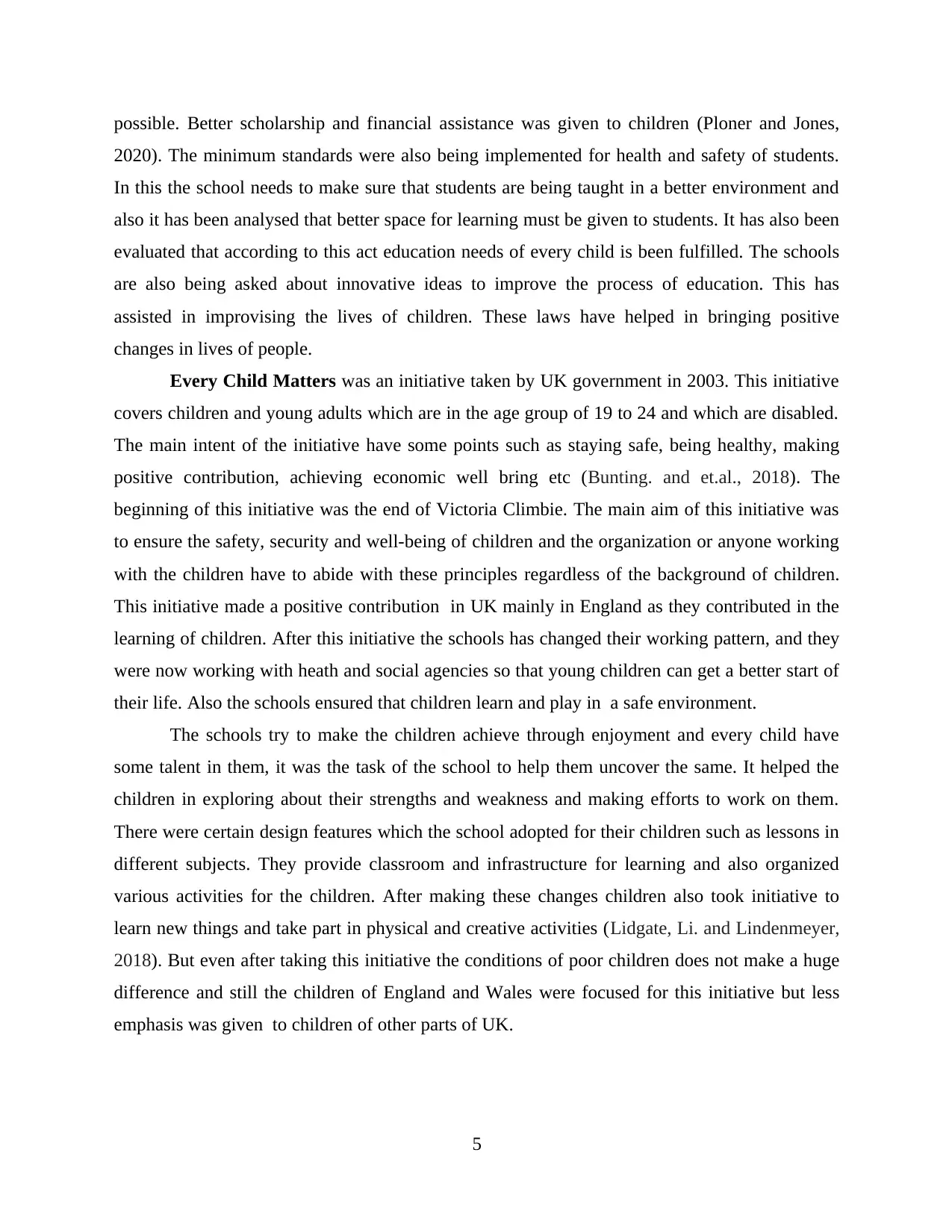
possible. Better scholarship and financial assistance was given to children (Ploner and Jones,
2020). The minimum standards were also being implemented for health and safety of students.
In this the school needs to make sure that students are being taught in a better environment and
also it has been analysed that better space for learning must be given to students. It has also been
evaluated that according to this act education needs of every child is been fulfilled. The schools
are also being asked about innovative ideas to improve the process of education. This has
assisted in improvising the lives of children. These laws have helped in bringing positive
changes in lives of people.
Every Child Matters was an initiative taken by UK government in 2003. This initiative
covers children and young adults which are in the age group of 19 to 24 and which are disabled.
The main intent of the initiative have some points such as staying safe, being healthy, making
positive contribution, achieving economic well bring etc (Bunting. and et.al., 2018). The
beginning of this initiative was the end of Victoria Climbie. The main aim of this initiative was
to ensure the safety, security and well-being of children and the organization or anyone working
with the children have to abide with these principles regardless of the background of children.
This initiative made a positive contribution in UK mainly in England as they contributed in the
learning of children. After this initiative the schools has changed their working pattern, and they
were now working with heath and social agencies so that young children can get a better start of
their life. Also the schools ensured that children learn and play in a safe environment.
The schools try to make the children achieve through enjoyment and every child have
some talent in them, it was the task of the school to help them uncover the same. It helped the
children in exploring about their strengths and weakness and making efforts to work on them.
There were certain design features which the school adopted for their children such as lessons in
different subjects. They provide classroom and infrastructure for learning and also organized
various activities for the children. After making these changes children also took initiative to
learn new things and take part in physical and creative activities (Lidgate, Li. and Lindenmeyer,
2018). But even after taking this initiative the conditions of poor children does not make a huge
difference and still the children of England and Wales were focused for this initiative but less
emphasis was given to children of other parts of UK.
5
2020). The minimum standards were also being implemented for health and safety of students.
In this the school needs to make sure that students are being taught in a better environment and
also it has been analysed that better space for learning must be given to students. It has also been
evaluated that according to this act education needs of every child is been fulfilled. The schools
are also being asked about innovative ideas to improve the process of education. This has
assisted in improvising the lives of children. These laws have helped in bringing positive
changes in lives of people.
Every Child Matters was an initiative taken by UK government in 2003. This initiative
covers children and young adults which are in the age group of 19 to 24 and which are disabled.
The main intent of the initiative have some points such as staying safe, being healthy, making
positive contribution, achieving economic well bring etc (Bunting. and et.al., 2018). The
beginning of this initiative was the end of Victoria Climbie. The main aim of this initiative was
to ensure the safety, security and well-being of children and the organization or anyone working
with the children have to abide with these principles regardless of the background of children.
This initiative made a positive contribution in UK mainly in England as they contributed in the
learning of children. After this initiative the schools has changed their working pattern, and they
were now working with heath and social agencies so that young children can get a better start of
their life. Also the schools ensured that children learn and play in a safe environment.
The schools try to make the children achieve through enjoyment and every child have
some talent in them, it was the task of the school to help them uncover the same. It helped the
children in exploring about their strengths and weakness and making efforts to work on them.
There were certain design features which the school adopted for their children such as lessons in
different subjects. They provide classroom and infrastructure for learning and also organized
various activities for the children. After making these changes children also took initiative to
learn new things and take part in physical and creative activities (Lidgate, Li. and Lindenmeyer,
2018). But even after taking this initiative the conditions of poor children does not make a huge
difference and still the children of England and Wales were focused for this initiative but less
emphasis was given to children of other parts of UK.
5
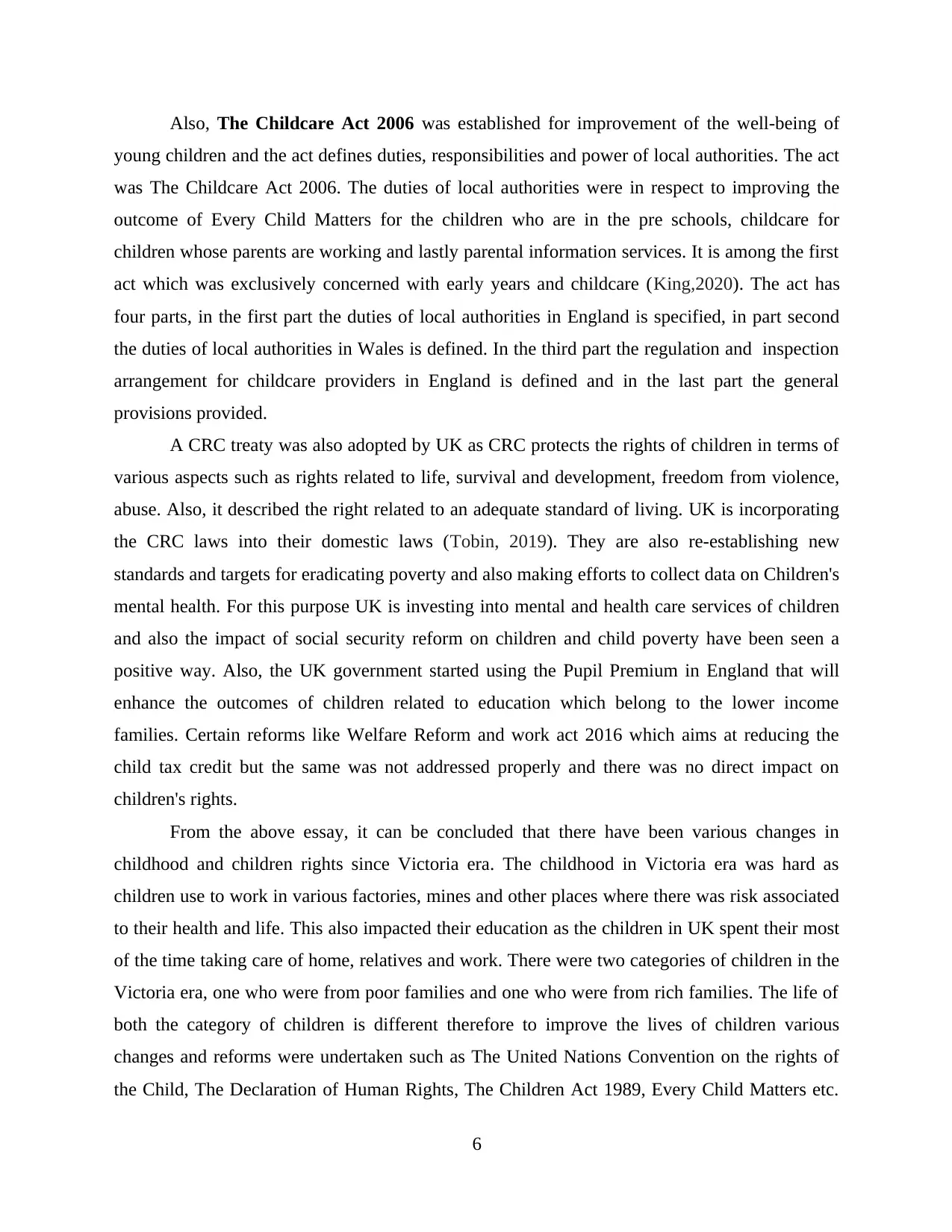
Also, The Childcare Act 2006 was established for improvement of the well-being of
young children and the act defines duties, responsibilities and power of local authorities. The act
was The Childcare Act 2006. The duties of local authorities were in respect to improving the
outcome of Every Child Matters for the children who are in the pre schools, childcare for
children whose parents are working and lastly parental information services. It is among the first
act which was exclusively concerned with early years and childcare (King,2020). The act has
four parts, in the first part the duties of local authorities in England is specified, in part second
the duties of local authorities in Wales is defined. In the third part the regulation and inspection
arrangement for childcare providers in England is defined and in the last part the general
provisions provided.
A CRC treaty was also adopted by UK as CRC protects the rights of children in terms of
various aspects such as rights related to life, survival and development, freedom from violence,
abuse. Also, it described the right related to an adequate standard of living. UK is incorporating
the CRC laws into their domestic laws (Tobin, 2019). They are also re-establishing new
standards and targets for eradicating poverty and also making efforts to collect data on Children's
mental health. For this purpose UK is investing into mental and health care services of children
and also the impact of social security reform on children and child poverty have been seen a
positive way. Also, the UK government started using the Pupil Premium in England that will
enhance the outcomes of children related to education which belong to the lower income
families. Certain reforms like Welfare Reform and work act 2016 which aims at reducing the
child tax credit but the same was not addressed properly and there was no direct impact on
children's rights.
From the above essay, it can be concluded that there have been various changes in
childhood and children rights since Victoria era. The childhood in Victoria era was hard as
children use to work in various factories, mines and other places where there was risk associated
to their health and life. This also impacted their education as the children in UK spent their most
of the time taking care of home, relatives and work. There were two categories of children in the
Victoria era, one who were from poor families and one who were from rich families. The life of
both the category of children is different therefore to improve the lives of children various
changes and reforms were undertaken such as The United Nations Convention on the rights of
the Child, The Declaration of Human Rights, The Children Act 1989, Every Child Matters etc.
6
young children and the act defines duties, responsibilities and power of local authorities. The act
was The Childcare Act 2006. The duties of local authorities were in respect to improving the
outcome of Every Child Matters for the children who are in the pre schools, childcare for
children whose parents are working and lastly parental information services. It is among the first
act which was exclusively concerned with early years and childcare (King,2020). The act has
four parts, in the first part the duties of local authorities in England is specified, in part second
the duties of local authorities in Wales is defined. In the third part the regulation and inspection
arrangement for childcare providers in England is defined and in the last part the general
provisions provided.
A CRC treaty was also adopted by UK as CRC protects the rights of children in terms of
various aspects such as rights related to life, survival and development, freedom from violence,
abuse. Also, it described the right related to an adequate standard of living. UK is incorporating
the CRC laws into their domestic laws (Tobin, 2019). They are also re-establishing new
standards and targets for eradicating poverty and also making efforts to collect data on Children's
mental health. For this purpose UK is investing into mental and health care services of children
and also the impact of social security reform on children and child poverty have been seen a
positive way. Also, the UK government started using the Pupil Premium in England that will
enhance the outcomes of children related to education which belong to the lower income
families. Certain reforms like Welfare Reform and work act 2016 which aims at reducing the
child tax credit but the same was not addressed properly and there was no direct impact on
children's rights.
From the above essay, it can be concluded that there have been various changes in
childhood and children rights since Victoria era. The childhood in Victoria era was hard as
children use to work in various factories, mines and other places where there was risk associated
to their health and life. This also impacted their education as the children in UK spent their most
of the time taking care of home, relatives and work. There were two categories of children in the
Victoria era, one who were from poor families and one who were from rich families. The life of
both the category of children is different therefore to improve the lives of children various
changes and reforms were undertaken such as The United Nations Convention on the rights of
the Child, The Declaration of Human Rights, The Children Act 1989, Every Child Matters etc.
6
⊘ This is a preview!⊘
Do you want full access?
Subscribe today to unlock all pages.

Trusted by 1+ million students worldwide

after all these reforms a positive change was seen in children with regard to their rights,
education, child labour etc. and improved their situation.
7
education, child labour etc. and improved their situation.
7
Paraphrase This Document
Need a fresh take? Get an instant paraphrase of this document with our AI Paraphraser
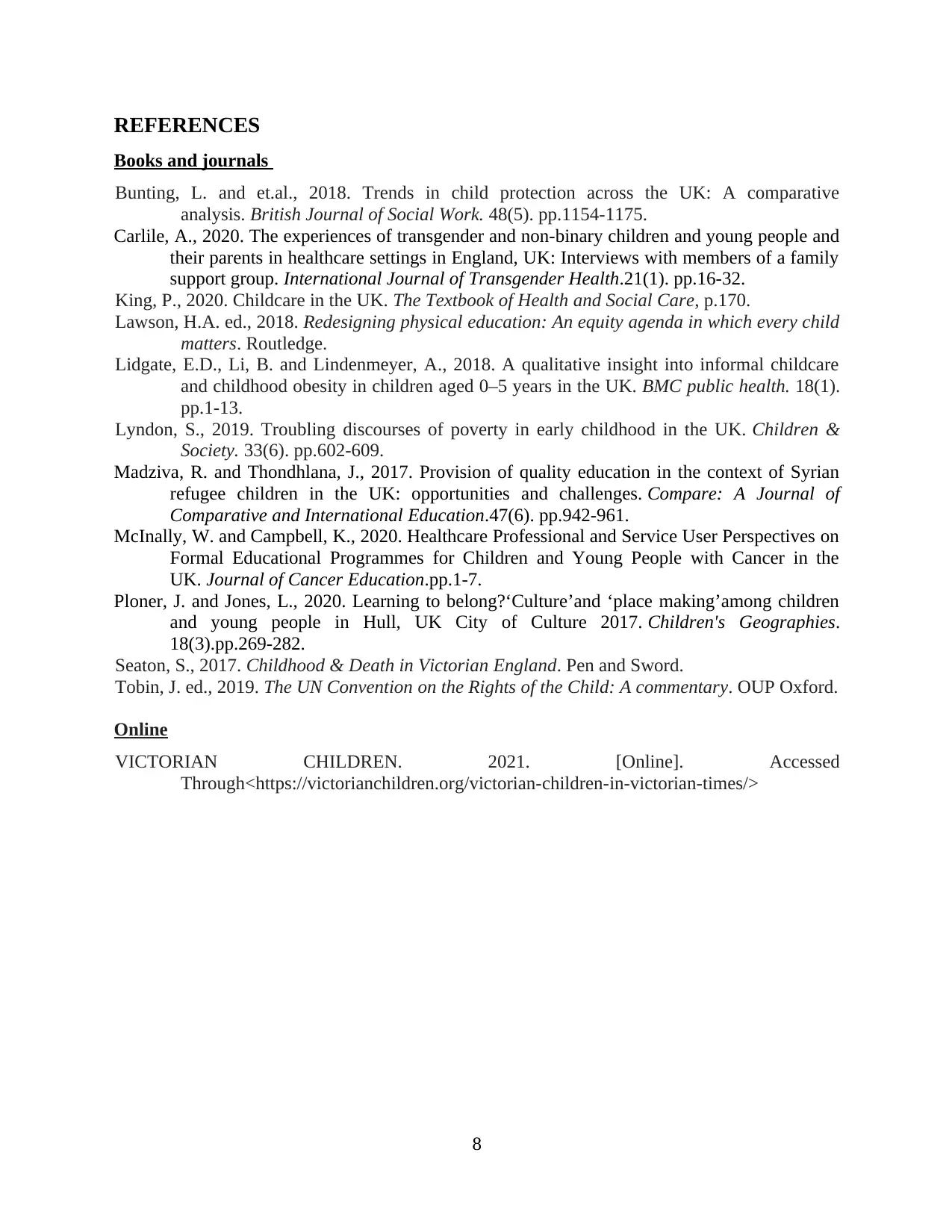
REFERENCES
Books and journals
Bunting, L. and et.al., 2018. Trends in child protection across the UK: A comparative
analysis. British Journal of Social Work. 48(5). pp.1154-1175.
Carlile, A., 2020. The experiences of transgender and non-binary children and young people and
their parents in healthcare settings in England, UK: Interviews with members of a family
support group. International Journal of Transgender Health.21(1). pp.16-32.
King, P., 2020. Childcare in the UK. The Textbook of Health and Social Care, p.170.
Lawson, H.A. ed., 2018. Redesigning physical education: An equity agenda in which every child
matters. Routledge.
Lidgate, E.D., Li, B. and Lindenmeyer, A., 2018. A qualitative insight into informal childcare
and childhood obesity in children aged 0–5 years in the UK. BMC public health. 18(1).
pp.1-13.
Lyndon, S., 2019. Troubling discourses of poverty in early childhood in the UK. Children &
Society. 33(6). pp.602-609.
Madziva, R. and Thondhlana, J., 2017. Provision of quality education in the context of Syrian
refugee children in the UK: opportunities and challenges. Compare: A Journal of
Comparative and International Education.47(6). pp.942-961.
McInally, W. and Campbell, K., 2020. Healthcare Professional and Service User Perspectives on
Formal Educational Programmes for Children and Young People with Cancer in the
UK. Journal of Cancer Education.pp.1-7.
Ploner, J. and Jones, L., 2020. Learning to belong?‘Culture’and ‘place making’among children
and young people in Hull, UK City of Culture 2017. Children's Geographies.
18(3).pp.269-282.
Seaton, S., 2017. Childhood & Death in Victorian England. Pen and Sword.
Tobin, J. ed., 2019. The UN Convention on the Rights of the Child: A commentary. OUP Oxford.
Online
VICTORIAN CHILDREN. 2021. [Online]. Accessed
Through<https://victorianchildren.org/victorian-children-in-victorian-times/>
8
Books and journals
Bunting, L. and et.al., 2018. Trends in child protection across the UK: A comparative
analysis. British Journal of Social Work. 48(5). pp.1154-1175.
Carlile, A., 2020. The experiences of transgender and non-binary children and young people and
their parents in healthcare settings in England, UK: Interviews with members of a family
support group. International Journal of Transgender Health.21(1). pp.16-32.
King, P., 2020. Childcare in the UK. The Textbook of Health and Social Care, p.170.
Lawson, H.A. ed., 2018. Redesigning physical education: An equity agenda in which every child
matters. Routledge.
Lidgate, E.D., Li, B. and Lindenmeyer, A., 2018. A qualitative insight into informal childcare
and childhood obesity in children aged 0–5 years in the UK. BMC public health. 18(1).
pp.1-13.
Lyndon, S., 2019. Troubling discourses of poverty in early childhood in the UK. Children &
Society. 33(6). pp.602-609.
Madziva, R. and Thondhlana, J., 2017. Provision of quality education in the context of Syrian
refugee children in the UK: opportunities and challenges. Compare: A Journal of
Comparative and International Education.47(6). pp.942-961.
McInally, W. and Campbell, K., 2020. Healthcare Professional and Service User Perspectives on
Formal Educational Programmes for Children and Young People with Cancer in the
UK. Journal of Cancer Education.pp.1-7.
Ploner, J. and Jones, L., 2020. Learning to belong?‘Culture’and ‘place making’among children
and young people in Hull, UK City of Culture 2017. Children's Geographies.
18(3).pp.269-282.
Seaton, S., 2017. Childhood & Death in Victorian England. Pen and Sword.
Tobin, J. ed., 2019. The UN Convention on the Rights of the Child: A commentary. OUP Oxford.
Online
VICTORIAN CHILDREN. 2021. [Online]. Accessed
Through<https://victorianchildren.org/victorian-children-in-victorian-times/>
8
1 out of 8
Related Documents
Your All-in-One AI-Powered Toolkit for Academic Success.
+13062052269
info@desklib.com
Available 24*7 on WhatsApp / Email
![[object Object]](/_next/static/media/star-bottom.7253800d.svg)
Unlock your academic potential
© 2024 | Zucol Services PVT LTD | All rights reserved.





